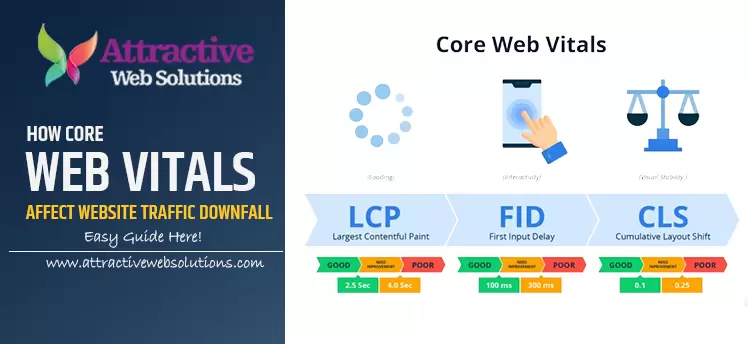In today’s digital landscape, Google places a premium on user experience, directly affecting how websites rank and, consequently, how much traffic they attract. One of the most significant updates to Google’s ranking factors in recent years has been Core Web Vitals, a set of user-centric metrics designed to measure loading speed, interactivity, and visual stability. If a site underperforms in these areas, it can lead to a noticeable core web vitals affect website traffic downfall. For many websites, poor Core Web Vitals scores can be directly linked to decreased visibility, engagement, and conversions.
At Attractive Web Solutions, we’ll walk you through how Core Web Vitals affect website traffic, why these metrics are essential for modern SEO, and the best practices for optimizing them. By the end of this guide, you’ll have a complete understanding of how to prevent the core web vitals downfall traffic that can result from poor performance in these areas.
What Are Core Web Vitals?
Core Web Vitals are a set of metrics that Google uses to quantify user experience. These metrics are currently essential for understanding how Core Web Vitals affect the quality of a site’s interaction with users. Google’s Core Web Vitals comprise three main elements:
Largest Contentful Paint (LCP): This measures loading performance by calculating the time it takes for the main content of a page to load. Ideally, LCP should happen within 2.5 seconds after the page starts loading.
First Input Delay (FID): FID measures interactivity by tracking the time it takes for the site to respond to the first user interaction, such as a button click or link tap. The target for FID is less than 100 milliseconds.
Cumulative Layout Shift (CLS): CLS measures visual stability by calculating unexpected layout shifts during the loading process. A good CLS score is below 0.1 to ensure a stable and smooth experience.
Each of these metrics impacts core web vitals affect website traffic by either enhancing or diminishing user experience, which in turn influences Google’s perception of a site’s quality and relevance.
How Core Web Vitals Affect Website Traffic: The Connection Between UX and SEO
Core Web Vitals are not only technical metrics but also significant Google ranking factors that directly impact SEO and website visibility. Here’s a closer look at how Core Web Vitals affect website traffic:
1. Direct Impact on Google Rankings
Core Web Vitals are part of Google’s Page Experience Update, meaning they now play a key role in determining rankings. Websites that meet Google’s standards for Core Web Vitals are more likely to rank higher in search results. Conversely, sites with poor Core Web Vitals scores may see their rankings drop, resulting in core web vitals downfall traffic. In a competitive market, ranking lower in search results leads to decreased visibility and fewer organic clicks.
- Example: Suppose two websites are competing for the same keyword. The site with better Core Web Vitals scores may rank higher, capturing more clicks, while the other loses traffic.
2. User Satisfaction and Engagement
User experience is a significant driver of site traffic and engagement. When Core Web Vitals metrics are not met, it affects users’ interaction with the site. For instance:
- Poor LCP (Loading Performance): If a page takes too long to load, users may become frustrated and abandon the site before it fully loads, resulting in a high bounce rate.
- High FID (Delayed Interactivity): If users experience a lag between clicking an element and receiving a response, they may perceive the site as unresponsive or low-quality.
- Unstable CLS (Visual Stability): Unexpected layout shifts disrupt the user experience, especially when elements move as users are trying to engage with them, leading to user frustration.
Such issues ultimately contribute to core web vitals affect website traffic by discouraging users from staying on the site, which can result in a negative user experience and lower engagement metrics.
3. Higher Bounce Rates and Lower Conversion Rates
Poor Core Web Vitals scores can lead to higher bounce rates as users are more likely to abandon slow or unresponsive sites. When bounce rates increase, conversions typically decrease because fewer users stay on the site to complete desired actions, such as making purchases or signing up for newsletters.
- Bounce Rate Impact: When users leave immediately, it signals to Google that the page isn’t meeting user expectations, which can lower rankings and contribute to core web vitals affect website traffic.
- Conversion Impact: For e-commerce and lead generation sites, poor Core Web Vitals can be detrimental to conversions. For example, a delay in interactivity (poor FID) during the checkout process can cause users to abandon their carts.
High bounce rates and low conversions due to poor Core Web Vitals have a compounding effect, leading to an even greater traffic downfall.
Signs That Core Web Vitals Are Contributing to Traffic Downfall
Identifying the signs of core web vitals downfall traffic can help you address issues before they impact your site’s performance. Here are some key indicators:
- Sudden Drops in Organic Traffic: A significant decline in organic traffic without changes in content or other ranking factors can indicate poor Core Web Vitals scores.
- Higher Bounce Rates on Mobile Devices: Mobile users expect fast, stable experiences. If bounce rates are high on mobile, it could point to issues with Core Web Vitals.
- Reduced Time on Page: If users are spending less time on your pages, it’s a sign that they are not engaging with your content, likely due to poor user experience metrics.
- Lower Mobile Rankings: Google’s mobile-first indexing emphasizes mobile usability. If your mobile rankings are declining, it’s worth reviewing your Core Web Vitals performance on mobile.
Core Web Vitals Optimization: How to Prevent Traffic Downfall
Improving Core Web Vitals is essential for preventing a decline in website traffic. Here’s how to address each Core Web Vitals metric:
1. Optimizing Largest Contentful Paint (LCP)
LCP measures loading performance, so the goal is to reduce the time it takes for the main content of the page to load.
Best Practices:
- Optimize Images: Compress and resize images to reduce loading times, especially for mobile.
- Minimize Server Response Time: Choose a fast hosting provider to improve response time.
- Use Lazy Loading: Load images and media only when they are in the user’s viewport to save resources.
- Enable Browser Caching: This allows frequently used assets to load faster on repeat visits.
By optimizing LCP, you can enhance the initial loading experience, ensuring that users don’t leave due to slow page loads and reducing core web vitals affect website traffic.
2. Improving First Input Delay (FID)
FID focuses on interactivity and measures the delay between a user’s interaction and the browser’s response.
Best Practices:
- Minimize JavaScript Execution: Reduce heavy JavaScript files or defer non-essential scripts to improve response times.
- Use a Content Delivery Network (CDN): A CDN distributes content globally to improve loading and interaction speed for users across different locations.
- Eliminate Unnecessary Third-Party Scripts: Limit third-party elements like social media widgets, which can slow down interaction times.
By improving FID, you ensure that users can interact with your site smoothly, enhancing their experience and supporting better core web vitals affect website traffic outcomes.
3. Enhancing Cumulative Layout Shift (CLS)
CLS affects visual stability and occurs when elements shift unexpectedly during loading, causing user frustration.
Best Practices:
- Assign Dimensions to Media: Define width and height for images, videos, and iframes to prevent unexpected layout shifts.
- Avoid Adding Content Above the Fold: Don’t inject content (like ads or banners) above the fold after the main content has loaded.
- Use CSS for Stable Layouts: Utilize CSS properties, like position anchors, to ensure elements remain stable.
A stable layout helps prevent user frustration and keeps engagement levels high, ultimately improving core web vitals affect website traffic metrics.
How to Monitor Core Web Vitals
Regular monitoring is crucial for maintaining Core Web Vitals performance and preventing traffic loss. Google provides several tools to help track these metrics:
- Google Search Console: The Core Web Vitals report in Search Console offers insights into your site’s LCP, FID, and CLS performance, flagging areas that need improvement.
- PageSpeed Insights: This tool provides an analysis of page speed and Core Web Vitals metrics, along with suggestions for improvement.
- Lighthouse (Chrome DevTools): Lighthouse offers a detailed audit of page performance and includes Core Web Vitals as part of its user experience metrics.
- Web Vitals Chrome Extension: For quick checks, this extension allows you to see Core Web Vitals metrics in real-time as you browse.
By using these tools, you can keep track of how Core Web Vitals affect website traffic and make adjustments as needed to maintain optimal performance.
Long-Term Benefits of Optimizing Core Web Vitals
Beyond avoiding traffic downfall, there are several long-term benefits to optimizing Core Web Vitals:
- Improved User Retention: Optimized Core Web Vitals enhance user experience, encouraging visitors to stay on your site longer and explore more content.
- Higher Conversion Rates: Smooth user experiences are linked to higher conversion rates, as visitors are more likely to complete actions on a fast, stable site.
- Enhanced Brand Perception: A seamless user experience positions your brand as professional and trustworthy, fostering customer loyalty.
- Future-Proofing for Google Updates: As Google continues to emphasize user experience, optimizing Core Web Vitals prepares your site for future changes and improves its resilience in the face of algorithm updates.
Conclusion: How Core Web Vitals Affect Website Traffic and Why You Should Act Now
Understanding how core web vitals affect website traffic is essential for every website owner in the modern SEO landscape. Poor Core Web Vitals scores lead to lower rankings, higher bounce rates, and lost conversions, resulting in an overall decline in traffic. By optimizing for LCP, FID, and CLS, you not only prevent traffic losses but also build a foundation for sustained growth in visibility and user satisfaction.
At Attractive Web Solutions, we specialize in creating web design and digital marketing strategies that prioritize user experience and Core Web Vitals optimization. If you’re concerned about core web vitals downfall traffic or want to elevate your website’s performance, reach out to us. Let us help you optimize your Core Web Vitals to drive growth, increase traffic, and stay competitive in today’s user-focused SEO environment.









0 Comments